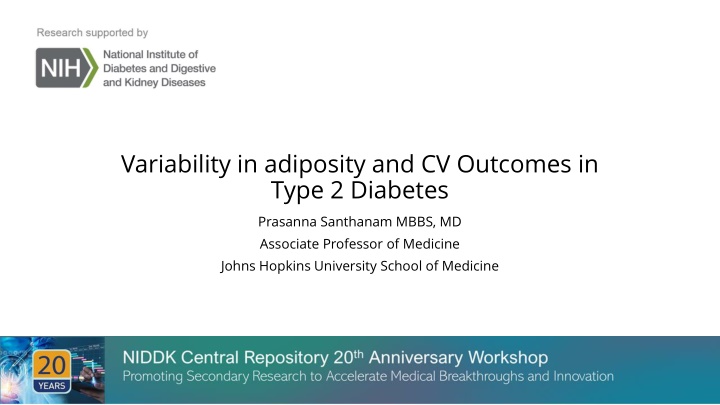
Variability in Adiposity and Cardiovascular Outcomes in Type 2 Diabetes Study
This research study explores the association between variability in adiposity markers and cardiovascular outcomes in adults with type 2 diabetes, focusing on the impact of intensive lifestyle intervention. Secondary analysis of data from the Look AHEAD trial is conducted to investigate the relationship between adiposity variability and mortality, considering traditional risk factors and covariates. The study aims to provide insights into the role of adiposity variability in cardiovascular health among individuals with type 2 diabetes.
Download Presentation

Please find below an Image/Link to download the presentation.
The content on the website is provided AS IS for your information and personal use only. It may not be sold, licensed, or shared on other websites without obtaining consent from the author. If you encounter any issues during the download, it is possible that the publisher has removed the file from their server.
You are allowed to download the files provided on this website for personal or commercial use, subject to the condition that they are used lawfully. All files are the property of their respective owners.
The content on the website is provided AS IS for your information and personal use only. It may not be sold, licensed, or shared on other websites without obtaining consent from the author.
E N D
Presentation Transcript
Variability in adiposity and CV Outcomes in Type 2 Diabetes Prasanna Santhanam MBBS, MD Associate Professor of Medicine Johns Hopkins University School of Medicine
Overview Research - Study hypothesis, methods and results Scientific accomplishments- Role of NIDDK Central Repository Scientific Career Helpful Hints
Research Work Study questions: Is there an association between variability in adiposity markers and cardiovascular outcomes and deaths among adults with type 2 diabetes? What is the strength of this association? Does intensive lifestyle intervention influence the relationship between this variability and CV outcomes/mortality? Study Design and Methods Secondary analysis of a prospective cohort study of included participants in the Action for Health in Diabetes (Look AHEAD) trial Look AHEAD was a multicenter, randomized clinical trial that evaluated the effects of an ILI compared with the standard of care (diabetes support and education [DSE]) on cardiovascular outcomes in persons with type 2 diabetes. The randomization groups included an ILI group (intervention group) and a DSE group (control group). The ILI aimed to achieve a 7% weight loss or greater via increased physical activity and decreased caloric intake. A total of 5145 participants aged 45 to 76 years were enrolled from August 2001 to April 2004 across 16 locations in the United States. The trial was terminated in 2012 Look Ahead data was obtained from the NIH NIDDK Central Repository Approval was obtained from Johns Hopkins IRB
Research Work Predictors: Traditional risk factors and covariates Variability of body mass index (BMI) and waist circumference (WC) across 4 annual visits, assessed using the coefficient of variation (CV) variability independent of the mean (VIM) standard deviation (SD) Outcomes: (1) All-cause mortality (2) Cardiovascular deaths (deaths from myocardial infarction [MI] or stroke) (3) CVD events (MI, stroke, and other causes) Covariates: Baseline - age, sex, race and ethnicity randomization arm, smoking status, alcohol consumption, duration of diabetes, and estimated glomerular filtration rate (eGFR) Study group covariates - mean HbA1c, mean ratio of total to high-density lipoprotein (HDL) cholesterol, mean systolic and diastolic blood pressures (BPs), use of BP meds
Research Work Statistical Analysis Studies stratified by randomization groups Characteristics reported across quartiles of CV of each adiposity marker as mean (SD) or median (IQR) for continuous variables or proportions for categorical variables. Cox proportional hazards regression models were used to calculate hazard ratios (HRs) and associated 95%CIs for each outcome Three nested models were constructed for each variability marker adjusting for different co-factors Model -1 adjusted for age, sex, race, and ethnicity Model -2 model 1 plus adjustment for current smoking, alcohol use, use of BP-lowering medication, mean total-to-HDL cholesterol ratio, eGFR, mean systolic BP, mean HbA1c level, and duration of diabetes Model 3 adjusted for variables in model 2 with further adjustment for mean BMI (in variability of BMI study), mean WC (in variability of WC study), or mean weight (in weight variability).
Research Work Summary: Waist Circumference showed similar Hazard Ratios for quartile 4 vs quartile 1 Variability in adiposity is associated with increased risk of morbidity and mortality in Type 2 DM Doing intensive lifestyle intervention mitigates that effect despite having variability in adiposity
Scientific Accomplishments NIH Central Repository Invaluable source of high-quality vetted data that is extremely hard to collect and obtain without extensive manpower and financial resources The material provided to the researcher in terms of the protocol, variable keys, main study as well as ancillary study data is comprehensive Has been very helpful for many scientific projects and will continue to be useful in the future The staff are very responsive and prompt to queries about the application process Has helped me grow in my career
Scientific Career Journey As a first-generation immigrant, obtaining an NIH grant is tough - unless you have a very good mentor with a track record of uninterrupted funding NIH/CDC (especially the NIDDK) repository datasets have been critical for establishing my credentials as a physician scientist in academic medicine I have used the datasets to publish high quality papers since these datasets have a proven track record of impeccable integrity and scientific rigor
Helpful Hints Check all the necessary requirements from Institutional IRB Ensure data safety Keep the NIDDK updated on the manuscript Strictly follow the acknowledgement guidelines






















